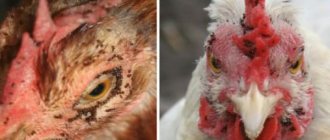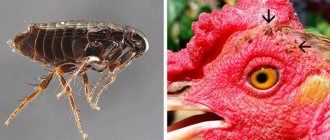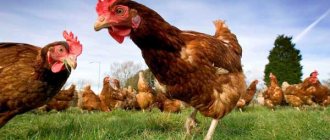8.1 Transportation
8.1.1 Eggs are transported by all modes of transport in accordance with the rules for the carriage of goods in force for this type of transport, subject to hygiene requirements.
8.1.2 Transportation of eggs intended for shipment to the Far North and equivalent areas - in accordance with GOST 15846.
8.2 Storage
8.2.1 At temperatures from 0 °C to 20 °C and relative humidity 85% - 88% storage:
— dietary eggs — no more than 7 days;
— table eggs — no more than 25 days;
- washed eggs - no more than 12 days.
At temperatures from minus 2 °C to 0 °C and relative air humidity of 85% to 88%, eggs are stored for no more than 90 days.
8.2.2 Storage of eggs intended for shipment to the Far North and equivalent areas - in accordance with GOST 15846.
8.2.3 The expiration date is established by the manufacturer indicating storage conditions.
GOST defines the concept of quality for products. It specifies requirements for classes, categories, as well as control methods, storage conditions and periods. The interstate standard, in addition to Russian, has an English name: “Food chicken eggs. Specifications".
Who applies GOST and where?
The standard is followed in 4 countries:
- The Republic of Moldova;
- Kyrgyz Republic;
- Russia;
- Republic of Belarus.
Applies to all chicken eggs intended for sale by any means. This includes retail and wholesale trade in raw materials, preparation of dishes in catering establishments, in bakery and confectionery industries.
This GOST does not affect quail eggs.
Preface
The goals, basic principles and basic procedure for carrying out work on interstate standardization are established by GOST 1.0-92 “Interstate standardization system. Basic provisions" and GOST 1.2-2009 "Interstate standardization system. Standards
interstate, rules and recommendations for interstate standardization. Rules for development, adoption, application, updating and cancellation"
Standard information
1 PREPARED BY the State Scientific Institution "All-Russian Scientific Research and Technological Institute of Poultry" (GNU "VNITIP"), Non-profit organization "Russian Poultry Union" (NO "Rosptitsesoyuz")
2 INTRODUCED by the Federal Agency for Technical Regulation and Metrology
3 ADOPTED by the Interstate Council for Standardization, Metrology and Certification (Protocol No. 50 of July 20, 2012)
The following voted for adoption:
| Short name of the country according to MK (ISO 3166) 004—97 | Code of the country according to MK (ISO 3166) 004-97 | Abbreviated name of the national standardization body |
| Belarus | BY | State Standard of the Republic of Belarus |
| Kyrgyzstan | KG | Kyrgyzstandard |
| Moldova | M.D. | Moldova-Standard |
| Russian Federation | RU | Rosstandart |
4 By Order of the Federal Agency for Technical Regulation and Metrology dated September 28, 2012 No. 441-st, the interstate standard GOST 31654-2012 was put into effect as a national standard of the Russian Federation on January 1, 2014.
5 This standard has been prepared based on the application of GOST R 52121-2003
6 INTRODUCED FOR THE FIRST TIME
Information on the entry into force (termination) of this standard is published in the “National Standards” index.
Information about changes to this standard is published in the “National Standards” index, and the text of the changes is published in the “National Standards” information indexes. In case of revision or cancellation of this standard, the relevant information will be published in the information index “National Standards”
© Standardinform, 2012
In the Russian Federation, this standard cannot be fully or partially reproduced, replicated and distributed as an official publication without permission from the Federal Agency for Technical Regulation and Metrology
What does the terminology mean?
GOST contains highly specialized terms:
- yolk slightly away from the center - visible, freely moving, slightly flattened when placed on a flat surface;
- protein of insufficient density - prone to spreading, does not hold its shape;
- washed eggs - treated with cleaning, washing, disinfecting preparations in accordance with the sanitary rules of the country in which the specification was adopted.
The air chamber is a cavity formed by the gassed space between two films inside the shell. It is located at the blunt end of the egg.
Content
1 Scope……………………………………………1
2 Normative references……………………………………………………..1
3 Terms and definitions……………………………………………………2
4 Classification………………………………………………………2
5 Technical requirements……………………………………………………2
6 Acceptance rules………………………………………………………..4
7 Control methods………………………………………………………..5
8 Transportation and storage……………………………………..7
INTERSTATE STANDARD
FOOD CHICKEN EGGS Technical specifications
Food chicken eggs. Specifications
Date of introduction - 2014—01—01
What standards were taken into account when creating
Links to legislative acts are given in section 2. When working with technical specifications, it is necessary to periodically check their relevance. They change numbers, names or are rejected as unnecessary.
At the time of writing, the following changes were recorded:
- ISO 7218-2015 instead of its 2011 counterpart - defines general recommendations and requirements for studies of the content of microorganisms in food products and animal feed.
- 31747-2012 - Establishes a methodology for the detection of a group of Escherichia coli.
- GOSTs, which determined the method for identifying microorganisms and bacteria of the genus Salmonella, have been cancelled.
- In the Russian Federation, the standard for scales for static use has become invalid.
There are no changes to the remaining items on the list. Amendments appear throughout the year and are published by FSUE Standardinform.
After changes to GOSTs, updated versions are used. If the document is canceled on the territory of the Russian Federation, and there is nothing in its place, then the link loses its relevance. The provision applies without taking these requirements into account.
How to control quality
Eggs are selected for organoleptic and physicochemical evaluation. The sample size depends on the amount received, but not less than 0.5%. Half of the test samples are left to determine the smell, shell purity, actual grade, and the condition of the white and yolk. 25% are sent for toxicity and microbiological studies.
To determine the characteristics of the internal contents, the egg is examined using an ovoscope. The height of the air chamber is determined using the measuring template.
Other designations
Additional symbols are designed to attract the attention of the consumer.
The trend to choose healthy foods is driven by the fashion for a healthy lifestyle. Today, manufacturers adjust ordinary products to fit it, using tricks that are invisible to the gullible buyer.
Village products in the store
Supermarkets work only with large suppliers who are able to pay decently for advantageous shelf space and provide the required volumes of products.
The attractive name “Village”, accompanied by a picture of chickens peacefully walking on a green field, is purely a marketing ploy.
Environmental friendliness
Eco-labeling is only possible for products whose production meets strict international and national requirements.
The oldest signs on the market indicate an increased level of product safety for the environment, but not all of them are used for food products.
These include:
- "Ecosign", European Union;
- "Blue Angel", Germany;
- "Environmental Choice", Canada;
- "White Swan", Scandinavian countries;
- "Eco-sign", Japan.
There is no unified eco-labeling system in Russia. Analogues of European variations are the icons: “Eco”; "Bio" The legality of their use in most cases remains on the conscience of the manufacturer.
In theory, such labeling should mean that the product is produced without the use of pesticides, hormones, fertilizers and growth stimulants.
The use of GMOs and any veterinary drugs, including antibiotics and vitamins, is also excluded.
Raising poultry to obtain such an egg is required in regions that are not exposed to high doses of radiation and free from other contamination.
The prefix “bio” means that laying hens should roam freely around the pasture without lack of natural feed.
A dozen eggs obtained under such conditions cost disproportionately more than usual. Whether to trust labels for similar products sold at average prices is an open question.
How to Determine the Freshness of Eggs by Dipping Them in Water
There are different ways to determine the freshness of eggs.
One of the most accessible is placing eggs in a container with cool water:
- the fresh one will lie flat on its side on the bottom,
- when it is a week old, the blunt end will be slightly raised,
- in a perpendicular position at the very bottom, the period is 2 weeks,
- rancid upon surfacing.
Important! If the white of a boiled egg has a grayish or bluish tint, then it should be thrown away. It is unsafe for humans to consume such a product.
How GOST changed
The current regulation does not contain applications. During its existence, it has undergone one revision in 2014.
In the updated version, the entry on establishing codes to indicate consumer requirements for eggs and packaging has been removed. The names of documents that are relied upon when determining the content of certain microorganisms and antibiotics are clarified.
Additionally, reference standards have been introduced for methods of microbiological analysis and determination of antibiotics or their residues.
How to transport and store
Types of transport according to GOST are not established. It is indicated that the equipment, marking, and processing of transport are carried out in accordance with the requirements of SanPiN. Carriers are required to comply with the rules for transporting goods.
The maximum shelf life of chicken eggs according to GOST is no more than (in days):
- dietary - 7;
- canteens - 25;
- washed - 12.
At the same time, air humidity is maintained at 85-88% and temperature 0–200 °C.
It is possible to increase the shelf life of table eggs to 90 days. The temperature regime is reduced to –2 and not higher than 0 °C. But storage conditions are determined only by the manufacturer.
Note! Instances with a white shell deteriorate faster. This is due to the presence of a coloring pigment in the colored shell. It interferes with gas exchange, so it takes longer to form an air chamber.
What requirements are defined by the standard?
The indicators of eggs must correspond to the provisions summarized in the table. If there are musty, putrid or other foreign odors, the batch is not allowed for sale.
Microbiological indicators, the content of harmful and toxic substances must be maintained at normal levels.
Table 1
Egg quality requirements:
| Type | Characteristics |
| Canteens with short-term storage | The protein requirements are the same as for dietary eggs: it is light, dense, and transparent. The gap between the films at the blunt end is no more than 7 mm and may shift slightly. The yolk is barely noticeable, somewhat mobile, durable. |
| Canteens, good for up to 90 days | The maximum height of the air chamber is 9 mm, its movement is permissible. The protein is transparent, light, and may not be dense enough. The yolk is displaced, but hardly noticeable and strong. |
| Dietary | The air chamber is no higher than 4 mm, motionless. The yolk is located clearly in the center, strong, without visible contours. |
Separate requirements are imposed on the shell: cleanliness, absence of droppings, blood stains, and damage.
Traces on the shell of dietary eggs, as a result of contact with flooring or other surfaces, can only occur once. These are small dots or stripes. On the shell of the table group, the total area of various spots does not exceed 1/8 of the entire surface.
Heavily contaminated eggs are treated with detergents approved in the territory of the country that has adopted the standard. If the product will be stored for a long time, it is prohibited to wash it.
Mucus remains on the surface of a freshly laid egg, which, when dried, forms a protective cuticle, a film. It contains a bactericidal substance - lysozyme. The protective cuticle covering the outside of the shell is damaged during processing, which reduces the shelf life of the egg.
How to take eggs
When the goods arrive, pay attention to the integrity and cleanliness of the packaging. Look at the markings on the container and on each egg. The first, second and third categories are designated by numbers, the highest and selective - by the letters “B”, “O”. The type is marked: “C” - table food, “D” - dietary. The sorting date is indicated on each unit.
The container contains the following information:
- address of the manufacturer;
- name, type, category;
- the nutritional value;
- date of manufacture;
- terms and storage rules;
- record of compliance of production conditions with GOST 31654-2012.
The batch is weighed. At least 94% must coincide in weight with the requirements. If permissible deviations are exceeded, a category is assigned that is lower than the declared one.
Each batch is supplied with one certificate of conformity and a veterinary certificate. Without copies of these documents, acceptance is prohibited.
Useful tips
For a skillful housewife, subjecting the product to heat treatment and then peeling it is not difficult.
However, not all consumers are culinary aces, so here are a few tips to make cooking and cleanup easier:
- Slightly salted water facilitates easy separation of the shell. Then the prepared product should be placed under a cold stream for several minutes. This procedure ends with immediate cleansing until the upper shell is easily separated from the protein part.
- A little shaking before cooking will help ensure even processing.
- It is not recommended to continue the cooking process for more than 20 minutes. The opposite result can result in harm to the body.
- The color characteristics of the shell do not affect the taste.
- The best cookware for heat treatment is a small saucepan. It will speed up the process and prevent the eggs from hitting the walls and each other.
- Culinary recipes using eggs mean the weight of one unit is 40 grams.
- Sticky feathers and droppings indicate a lack of hygiene rules at a poultry farming enterprise, but not the environmental friendliness of the product.
The modern market offers the buyer not only regular products, but also those enriched with vitamins - such products are labeled “Fitness”.
Categories according to GOST
The primary criterion for assigning an egg to a certain group is its weight characteristics. Modern standards divide poultry products into the following GOST egg categories.
Higher
This group includes goods, one unit of which weighs more than 75 grams. The product is marked with the letter “B”. It can be stored for a long time by first peeling it.
Selected
The egg is somewhat inferior in food mass and size to the previous type. The weight characteristic of a selected egg is 65-74.9 g. The blunt end of the product or package is indicated by a large “O”.
First
The first category occupies third position in this table of ranks. Covers products weighing one unit of 55-64.9 grams, determined by the presence of the number “1” during labeling.
Second
This type includes goods weighing 45-54.9 grams, designated by the index “2”.
Third
The last category is the third. Its weight and dimensions are inferior to analogues of higher classifications. The mass of the product is 35-44.9 g, which is indicated on the blunt end or packaging by the corresponding number “3”.











